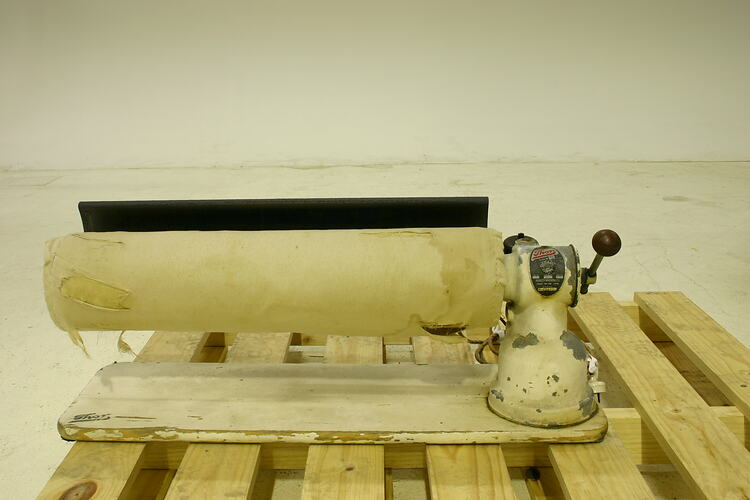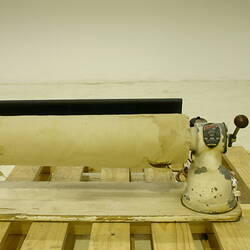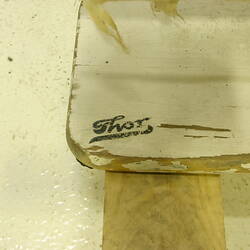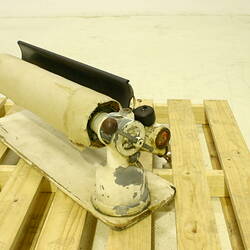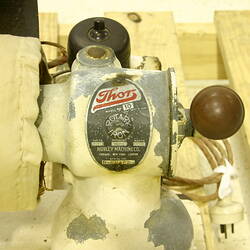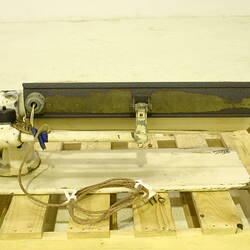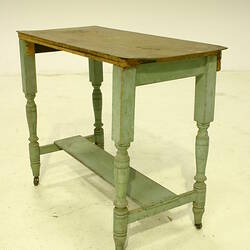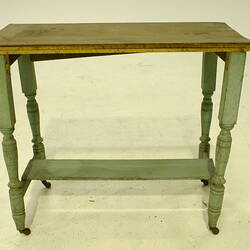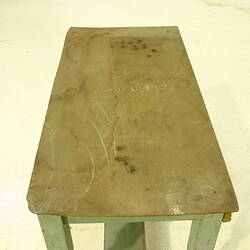Summary
Alternative Name(s): Rotary Ironer
Thor model 10 rotary iron made by the Hurley Machine Company, on wooden table base. It was rated at 230 volts.
The iron was used in Terang, Victoria. It was originally purchased from the SEC by the Terang Laundry. However, they could not afford to continue making payments and it was offered to the donor's father, who was the manager of McDonald Brothers Stock & Station (later Dalgety) agency in Terang. He was friends with the manager of the SEC who suggested his wife would like it because they had a large family of eight children. The donor's family took ownership of the rotary iron about 1918. The Terang Laundry continued to operate but apparently without the ironing service.
According to the donor, her mother enjoyed ironing with this industrial machine and thought it was wonderful. She used it to iron sheets, table cloths and clothes, etc., for her large family. The roller moved around when the handle was pulled and items were spun through. The donor's mother would dampen the tablecloths and other items before putting them through the machine, then fold them. She finished off shirts with a general iron as the machine wasn't entirely suited to such clothing. It was 'marvellous on pillow cases'. The girls of the family would assist with the ironing too.
The donor's mother washed Monday and the clothes were hung to dry on rafters in the kitchen ceiling. She ironed on Tuesday. On Wednesday she went to Warrnambool with her husband who attended the stock sales and she went shopping for fabric and other things, but not food as this was bought in Terang. On Thursday she did the gardening and some cooking, on Friday she did most of the cooking, and on Saturday the family went to the footy.
The ironing machine was normally used in the wash house, a weatherboard building down the back of the house. The machine sat on an old wash stand which had a piece of masonite on top and wheels. It could be rolled around the wash house when necessary. In winter when it was cold the ironing machine was brought into the house to be used. Two of the children would carry it from laundry to house. The backyard was paved with bricks so it had to be carried not wheeled. The ironing machine stayed in Terang till the last sister living there moved to Melbourne in 1981. It was last used in about 1985. It is apparently still in working order.
Physical Description
Rotary iron comprising main cylinder with fabric covering (now stained), cast metal support arm painted off-white (paint now chipped) and rectangular wooden base. A handle with knob controls the operation of a plate that presses the fabric against the cylinder during use. The iron has a Bakelite switch and brown power cord, with white plug at the end (apparently a replacement). It sits upon a separate wooden base: a table with turned legs, painted green, with castors at feet, and a bowed wood top made from several pieces of timber.
Significance
This ironing machine is significant because of its provenance - its use shifted from an industrial to a domestic context. As a domestic iron it is unusual because it was an industrial machine, whereas all of the current domestic irons in the collection are small hand irons. It can therefore offer new insights into laundry work. Its impact on the women of the family was that they spent less time ironing because this machine made it more efficient. The fact that an industrial ironing machine was used in a domestic context also tells us that the family was relatively wealthy to be able to afford it.
Note that domestic ironing machines were known as flat pressers or rotary ironers. The one on offer is a rotary iron as the fabric is fed, under pressure, over a heated cylinder. These were developed in the United States in the 1920s and 1930s, and were again launched onto the market in the 1960s. These machines never found commercial success, with most domestic users of irons preferring smaller hand held devices.
This ironing machine is also significant for its technology - Thor is a well known American company who invented the first electrically powered washing machine in 1907. Thor became one of the most recognizable brands in the USA and their washers remained popular until the 1950's, when the company began giving each new range of laundry products a different brand. Over the next decade, the Thor brand name disappeared. In 2001 the historic Thor brand was reintroduced for a new range of laundry appliances. [http://www.thorappliances.com/index.php] Thor is an innovative company. They currently make water and power efficient appliances. In the past they made a combined clothes and dish washing machine, which the museum holds.
This ironing machine also demonstrates the history of Australian manufacturing in the early 20th century. Australia's appliance manufacturing industry in this period appears to be minimal. At this time we relied on imported electrical domestic appliances, generally from the USA or the Britain. Local manufacturing tended to develop post World War II as a result of government incentives.
Finally, this object is unrepresented in the collection- there appears to be no early 20th century industrial ironing machines. There are currently two industrial ironing machines in total, under the classification of Industries. They are late 20th century table top steam irons from the Gloweave factory. These have no details listed regarding their date of manufacture but presumably were contemporary to the late 20th century. [SH 970533 Table - Steam Iron and Pressing; SH 970532 Table - Steam Iron and Pressing] This machine will round out the range of ironing technologies used in the home in the 20th century.
More Information
-
Collection Names
-
Collecting Areas
-
Acquisition Information
Donation from Evelyn Ditty, 12 Jan 2005
-
Maker
Hurley Machine Co., Chicago, Illinois, United States of America, 1910-1918
-
Inscriptions
Maker's label attached to one side of support arm, inscribed 'Thor / MODEL NO. 10 / PAT. APPLD FOR / ROTARY / IRON / 230 / VOLTS / 50CYI / CURRENT / 1230 WATTS / HURLEY MACHINE CO / CHICAGO - NEW YORK - LONDON / SERIAL NO. / R-22465'.
-
Model Name or Number
-
Brand Names
-
Classification
-
Category
-
Discipline
-
Type of item
-
Overall Dimensions
25.5 cm (Length), 84 cm (Width), 33 cm (Height)
Iron only
-
Overall Dimensions
46 cm (Length), 92 cm (Width), 78.5 cm (Height)
Stand only
-
Keywords
Electrical Equipment, Industrial Machinery, Ironing, Laundering, Manufacturing
